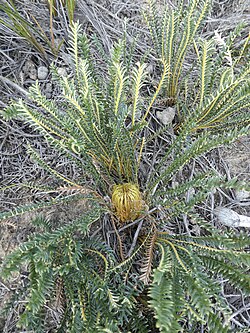Biology:Banksia arctotidis
| Banksia arctotidis | |
|---|---|

| |
| Near Ravensthorpe | |
| Scientific classification | |
| Kingdom: | Plantae |
| Clade: | Tracheophytes |
| Clade: | Angiosperms |
| Clade: | Eudicots |
| Order: | Proteales |
| Family: | Proteaceae |
| Genus: | Banksia |
| Subgenus: | Banksia subg. Banksia |
| Series: | Banksia ser. Dryandra |
| Species: | B. arctotidis
|
| Binomial name | |
| Banksia arctotidis | |
| Synonyms[1] | |
| |
Banksia arctotidis is a species of prostrate shrub that is endemic to the southwest of Western Australia. It has leaves that are pinnately divided to the midrib, cream-coloured flowers and hairy, egg-shaped fruit.
Description
Banksia arctotidis is a prostrate shrub that typically grows to a height of 0.5–1 m (1 ft 8 in–3 ft 3 in), width of 0.7 m (2 ft 4 in) and has a short underground stem. The leaves are linear, 80–150 mm (3.1–5.9 in) long and 5–8 mm (0.20–0.31 in) wide, pinnately divided to the midrib with between 25 and 45 sharply pointed lobes on each side. The flower spikes are surrounded by hairy thread-like, egg-shaped and oblong bracts and are composed of between 75 and 100 individual flowers. The perianth is 26–31 mm (1.0–1.2 in) long and yellow cream-coloured or yellowish brown. Flowering occurs between September and October and the fruit is a partly hairy, egg-shaped follicle 10–14 mm (0.39–0.55 in) long.[2][3]
Taxonomy and naming
This banksia was first formally described in 1830 by Robert Brown who gave it the name Dryandra arctotidis and published the description in Supplementum primum Prodromi florae Novae Hollandiae.[4][5] In 2007, Austin Mast and Kevin Thiele changed the name to Banksia arctotidis.[6] The specific epithet (arctotidis) is a reference to the genus Arctotis.[7]
Distribution and habitat
Banksia arctotidis grows on sandy soil in kwongan south from Kojonup and Ongerup through the Stirling Range National Park to near Albany.
Ecology
An assessment of the potential impact of climate change on this species found that its range is likely to contract by between 50% and 80% by 2080, depending on the severity of the change.[8]
Conservation status
This banksia is classified as "not threatened" by the Western Australian Government Department of Parks and Wildlife.[2]
References
- ↑ 1.0 1.1 "Banksia arctotidis". https://biodiversity.org.au/nsl/services/apc-format/display/205077.
- ↑ 2.0 2.1 "Banksia arctotidis". FloraBase. Western Australian Government Department of Parks and Wildlife. https://florabase.dpaw.wa.gov.au/browse/profile/32684.
- ↑ George, Alex S. (1999). Flora of Australia. 17B. Canberra: Australian Biological Resources Study, Canberra. pp. 351–352. https://www.environment.gov.au/system/files/pages/6d8c5c3b-8545-437e-b9b3-944ac95ee07a/files/flora-australia-17b-proteaceae-3-hakea-dryandra.pdf. Retrieved 24 March 2020.
- ↑ "Dryandra arctotidis". APNI. https://id.biodiversity.org.au/instance/apni/526593.
- ↑ Brown, Robert (1830). Supplementum primum prodromi florae Novae Hollandiae. London: Typis R. Taylor. p. 39. https://www.biodiversitylibrary.org/item/77294#page/553/mode/1up. Retrieved 25 March 2020.
- ↑ "Banksia arctotidis". APNI. https://id.biodiversity.org.au/instance/apni/614228.
- ↑ Francis Aubie Sharr (2019). Western Australian Plant Names and their Meanings. Kardinya, Western Australia: Four Gables Press. p. 136. ISBN 9780958034180.
- ↑ Fitzpatrick, Matthew C.; Gove, Aaron D.; Sanders, Nathan J.; Dunn, Robert R. (2008). "Climate change, plant migration, and range collapse in a global biodiversity hotspot: the Banksia (Proteaceae) of Western Australia". Global Change Biology 14 (6): 1–16. doi:10.1111/j.1365-2486.2008.01559.x. Bibcode: 2008GCBio..14.1337F.
- Cavanagh, Tony; Pieroni, Margaret (2006). The Dryandras. Melbourne: Australian Plants Society (SGAP Victoria); Perth: Wildflower Society of Western Australia. ISBN 978-1-876473-54-9. OCLC 149312882.
- Mast, Austin R.; Thiele, Kevin (2007). "The transfer of Dryandra R.Br. to Banksia L.f. (Proteaceae)". Australian Systematic Botany 20: 63–71. doi:10.1071/SB06016.
Wikidata ☰ {{{from}}} entry
 |


